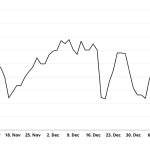
The airline industry continues to heal from the Covid-19 pandemic. With aircraft sitting empty and idle on tarmacs around the world, the global aviation industry suffered. It lost an estimated $168 billion during the health crisis, according to an assessment by consulting firm McKinsey & Co. Airlines took on massive amounts of debt to stay afloat even as they saw their stock prices crushed.
However, travel demand has rebounded strongly this year, helping to drive ticket sales and bolster revenues. And yet, airlines have faced new challenges in recent months.
These include expensive new labour deals with pilot unions and a sharp rise in fuel costs as crude oil prices rose over the summer months to more than $90 a barrel. War in the Middle East and an economic slowdown in China have further complicated the near-term outlook for carriers. Despite these facts, the global aviation industry is headed for better days as we steer into next year. Let’s examine three airline stocks that could make a comeback in 2024.
American Airlines (AAL)

American Airlines (NASDAQ:AAL) has been in a funk since the carrier reported a Q3 loss. Essentially, the news lowered its profit forecast for the remainder of 2023.
The world’s largest airline reported losses of $545 million, or 83 cents a share. This was down from a profit of $483 million, or 69 cents a share from a year earlier. Revenue in Q3 totaled $13.48 billion versus $13.52 billion that was the consensus expectation of analysts who cover the airline. The price of crude oil has been steadily rising in recent months and is now around $85 a barrel. Fuel prices are one of American Airlines’ biggest expenses.
AAL executives blamed the poor financial results on higher fuel prices and an expensive new labour agreement with its pilots’ union over the summer. In August, AAL signed a new contract with its 15,000 pilots that provides them with more than $9 billion of additional compensation and benefits. Looking ahead, American Airlines now expects to earn between $2.25 and $2.50 a share for all of this year. The new guidance is below previous forecasts for earnings of $3 to $3.75 a share, but largely in line with analysts’ consensus views.
Yet, optimism is prevailing. Crude oil prices have started to trend lower, interest rates have likely peaked and are forecast to come down in 2024. Further, the U.S. economy remains resilient, and the labor costs will eventually be passed on to customers through higher fees and fares. AAL stock is down 13% on the year and trading at a 52-week low. A bottom is surely within sight.
United Airlines (UAL)

United Airlines (NASDAQ:UAL) fared better than American Airlines with its recent Q3 print, announcing financial results that beat Wall Street forecasts. However, UAL stock fell 6% after the company lowered its outlook. UAL posted earnings per share (EPS) of $3.65 versus $3.35 that had been expected among analysts. Revenue came in at $14.48 billion compared to $14.44 billion that was anticipated. The company’s revenue was up 12% from $12.88 billion a year earlier.
Despite the earnings beat, United Airlines warned that more expensive jet fuel and a halt to its Tel Aviv flights due to the Israel-Hamas war will hurt profits in the current quarter. The company noted that fuel prices have risen 25% since the start of the summer. Also, UAL had run more service to Israel than any other U.S.-based airlines. The war in the Middle East has cast a cloud of uncertainty over UAL stock in the near-term. The airline said it now expects EPS of between $1.50 and $1.80 a share for Q4, which is below Wall Street forecasts of $2.06.
Despite the lowered guidance, United Airlines Q3 results beat comes after a strong summer travel season. At that time, the carrier saw revenue growth for international destinations outpace sales of U.S. domestic tickets. This bodes well for future bookings and financial results, especially with United Airlines forecasting a strong holiday travel season. UAL stock is down 7% year to date (YTD) and near a 52-week low.
Delta Air Lines (DAL)

Delta Air Lines (NYSE:DAL) is boasting strong Q3 results. Profits during the summer season rose nearly 60% due to strong travel demand throughout the season.
Additionally, Delta benefitted from a big rebound in international travel. The carrier reported EPS of $2.03 versus $1.95 that was forecast by Wall Street analysts. Revenue in Q3 totaled $14.55 billion compared to the expected $14.56 billion and was up 13% year over year (YOY).
Delta’s trans-Atlantic flights were especially strong. Revenue generation from international flights rose 34% from last year. Also, the carrier is witnessing a sharp increase in demand for premium seats such as business class and premium economy. Main cabin revenue came in at $6.62 billion, up 12% from a year ago. However, premium product sales rose 17% to $5.11 billion during the quarter.
Looking ahead, Delta forecast full-year earnings toward the low end of previous estimates, citing rising fuel prices. However, full-year earnings of $6 to $6.25 per share is expected, after forecasting $6 to $7 previously.
Investors bullish on DAL stock cite the company expects solid travel demand in the last three months of the year during the holidays. In June, Delta reinstated its quarterly dividend that was suspended in March 2020, now paying stockholders a dividend of 10 cents per share each quarter. DAL stock has dipped 4% YTD and is trading near a 52-week low, prompting a buy the dip.
On the date of publication, Joel Baglole did not have (either directly or indirectly) any positions in the securities mentioned in this article. The opinions expressed in this article are those of the writer, subject to the InvestorPlace.com Publishing Guidelines.




